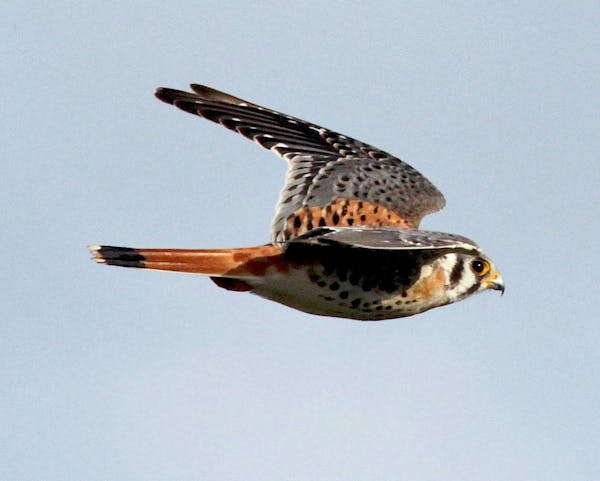Like the movement of a school of fish, a flock of blackbirds flew in waves above bronzed fields as sunset neared. An open window let in the squawky honks of Canada geese flying in Vs over trees. Cranes and egrets gathered in grasses and near wetlands, feasting before the seasonal liftoff and journeys south.
Signs of migration can be seen across Minnesota's rural landscapes every fall, but new technologies and expanding research are raising the wow-factor.
"Birds go farther and faster and have broader migratory routes than we thought," said Dr. Jeff Wells, science and policy director with the Boreal Songbird Initiative. "This new evidence shifts our understanding of what migratory birds need."
A recent report, which also involved Ducks Unlimited and the Cornell Lab of Ornithology, showed that northern landscapes matter as much, if not more, than winter tropics. Billions of migratory birds use them for nesting grounds before taking epic journeys south.
For most species, especially songbirds, the journey takes place quietly, stealthily as people sleep. An estimated 30 million to 50 million birds fly across the United States and Canadian border each night from late summer through November, with the cloak of darkness protecting them from predators. Birders attuned to modern tracking watch weather radar as the sun goes down.
"You'll see these clouds show up on radar as [birds] lift off at night," Wells said. "It's pretty striking in many areas."
Radar, geotagging, and other technologies are making it easier for biologists and researchers to follow the journeys of an estimated 300 species that breed and nest in the boreal forest. That biome roughly stretches from the interior of Alaska and north of Canada's prairie before dipping into the northern United States and east to Newfoundland. Minnesota ranks among the most important U.S. states for the boreal landscape, which includes the highest amount of surface freshwater in the world along with some of its largest and most notable lakes.
"We sometimes call it 'the forest of blue,' " Dr. Wells said.
Migration treaty turns 100
With birds crossing not just countries, but continents, it takes a global effort to protect their habitats and migratory routes. The United States and Canada signed the historic Migratory Bird Treaty 100 years ago when high demand for fashionable feathers, mass kills during migration, and unregulated hunting almost wiped out several species.
Birds once on the verge of extinction or rare, such wood ducks, egrets, terns and gulls, have become common once again. Others continue to struggle, including the Eskimo curlew, the American golden-plover, and bobolinks, which can be seen on western Minnesota prairies.
Wildlife advocates say logging, pipelines, climate change and competition with other birds are shrinking habitats. They are pushing back with efforts to protect nesting areas, land-use plans, vital stops on migration routes, and continuing research on the movement of birds using satellite tracking, radio telemetry, radar imaging, genetic markers, geolocators and citizen science efforts.
Local birders who report sightings from their backyards or fall hikes can help build databases such as Cornell's eBird that maps where a species has been seen. Western Minnesota's bobolink, for example, ultimately makes its way to Argentina until warmth returns to the Midwest.
Satellite tagging, which can be seen on sites such as wildlifetracking.org, has shown species such as the Hudsonian godwit will fly from north of Alaska, across Canada, then south for three days straight across ocean, rest on an island, then continue for another two to three days without stopping on their way to the tip of South America. That's with good weather and no hurricanes hurtling them off-course.
"The marathon journeys we're discovering are beyond what people would think a little bird could do," Wells said.
Along Hawk Ridge
On a crisp fall day with winds blowing south and east, birders know to line Skyline Drive high above downtown Duluth. They watch for hawks, eagles, falcons and songbirds that have followed the shore of Lake Superior and ridden the thermals — updrafts that rise up from the lake and funnel them south.
"The higher they get in elevation, the longer they can soar and save their energy," says Janelle Long, executive director of Hawk Ridge Bird Observatory, which has been counting and banding hawks and other birds for 45 years.
While the 365-acre observation and research area is best known for sightings of broadwing hawks, there are more than 20 species of raptors moving through the area, along with thousands of songbirds that can be tricky to see without the volunteers and spotting scopes that are available during peak migration from mid-September through late October to help visitors discern wing shapes and flight patterns.
The area draws the largest migration of northern goshawks anywhere. That fact draws birding lifers to the area, along with the chance to see a rare peregrine falcon or gyrfalcon or to observe up close birds that researchers may be able to net and band.
"We have visitors coming from all over the world," Long said.
Generally, smaller birds with the longest journeys tend to fly from the boreal forest and through Minnesota in September, leaving the larger birds with shorter journeys to make their way in October, said Margie Menzies, public program director at Hawk Ridge. Other later-migrating birds include kinglets, hermit thrushes and white-crowned sparrows, juncos and snow buntings.
"It's a fascinating parade of species," Menzies said.
Lisa Meyers McClintick is a freelance writer based in St. Cloud.

Twins lose second in a row to Blue Jays as bullpen falters late

Twins pitcher Ober struggling to regain fastball velocity

The PWHL's growth comes with a price for a Minnesota Frost team building a potential dynasty
What is the 'House settlement,' and what does it mean for the Gophers and NCAA?

